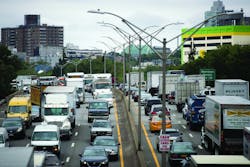I’ve spent a lot of time in previous posts talking about the things vehicle manufacturers, fleets and drivers can do to improve their fuel economy and freight efficiency. However, they aren’t the only ones that bear the burden of moving goods more efficiently. I am going to talk about the responsibility of some other groups that play a role in how well trucks are able to get goods from point A to point B.
Let’s start with federal, state and local governments. The conditions of the nation’s roads and bridges are an impediment to the efficient movement of goods. Washington needs to take action to find a sustainable funding source for infrastructure improvements. State and local governments need to do their part as well in maintaining local roads and bridges.
In addition, traffic congestion and bottlenecks are costing trucking big time. According to the American Transportation Research Institute: “Congestion is estimated to have caused the trucking industry to consume an additional 6.87 billion gallons of fuel in 2016.” ATRI says this represents 12% of the industry’s fuel consumption and added $15.74 billion to its fuel bill. “This consumption also resulted in 67.3 million metric tons of excess carbon dioxide emissions.”
Clearly, there is work to be done here.
Then there are the shippers. Now is a good time to take a look at your product packaging. How good a job are you doing minimizing the excess packaging around your product? Less packaging equals smaller boxes or cartons, which means more boxes/cartons are able to fit into a truck, which helps improve freight ton efficiency.
It also is not a bad idea to look at your delivery windows. Is there a way you can work with carriers to adjust delivery windows to allow them to do a better job optimizing their routes? And of course, there is the industry-wide problem of detention. DOT looked at detention from a safety and driver pay standpoint, but trucks sitting around docks are in many cases burning extra fuel — fuel that would better be used when the truck is moving making its deliveries.
Improved freight efficiency isn’t just the responsibility of vehicle manufacturers, fleets and drivers. Everyone involved in the movement of goods can play a rule in making the process a little (or a lot) more efficient. Working together we can make this happen.
About the Author

Michael Roeth
Executive Director
Michael Roeth is the executive director of the North American Council for Freight Efficiency. He serves on the second National Academy of Sciences Committee on Technologies and Approaches for Reducing the Fuel Consumption of Medium and Heavy-Duty Vehicles and has held various positions with Navistar and Behr/Cummins.
